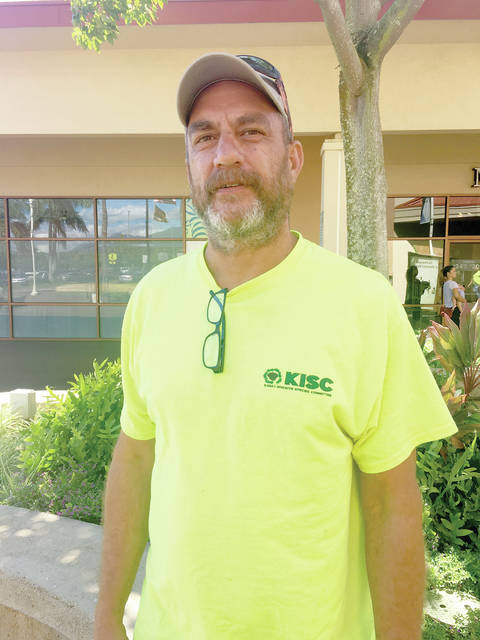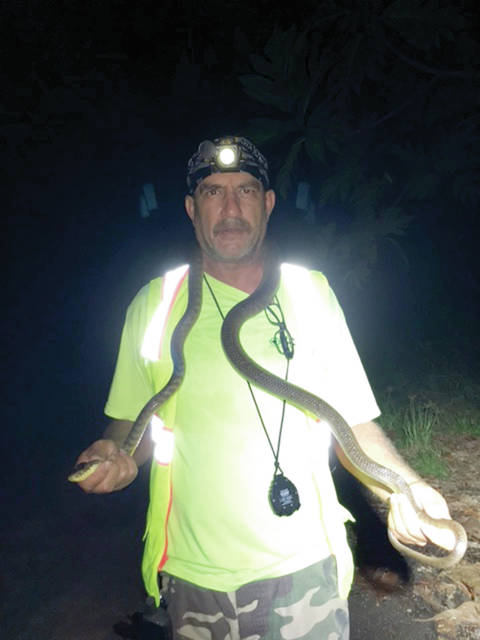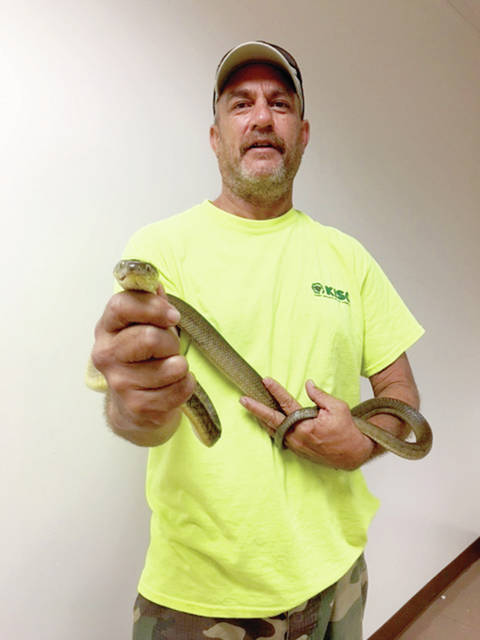Talk Story: Ray Kahaunaele

Jessica Else / The Garden Island
Ray Kahaunaele

Photo courtesy Ray Kahaunaele
Kauai Invasive Species Committee Field Operations Supervisor Ray Kahaunaele learns techniques for rapid response to brown tree snake sightings during an August training on Guam.

Photo courtesy Ray Kahaunaele
Ray Kahaunaele of the Kauai Invasive Species Committee handles a brown tree snake during an August training on Guam.
Little fire ants and long-thorn kiawe, coqui frogs and cattail, false kava and mongoose; all have the potential to destroy native species and change ecosystems if they get a foothold on Kauai.
Little fire ants and long-thorn kiawe, coqui frogs and cattail, false kava and mongoose; all have the potential to destroy native species and change ecosystems if they get a foothold on Kauai.
These invasive species, as described by the state’s Hawaii Invasive Species Council, are both harmful to the environment, economy or human health and aren’t native to Hawaii — meaning they got to the islands with some sort of human assistance.
They’re part of Kauai Invasive Species Committee’s list of species of concern. They are among more than 20 target species that are either on island in limited numbers or are highly invasive and would cause major problems should they show up.
KISC is one of many invasive species committees which are established on each island and have a list of priority species unique to each island as well as strategies to manage those species.
But before invasive species get to the islands, they have to make it through a proverbial biosecurity net, designed by the state.
When it comes to travel and shipping from the Mainland to Hawaii, as well as inter-island travel and shipping, the Department of Agriculture has rules to shut down invasive species introduction, but every so often something slips through.
Most recently, on Aug. 30 a live skunk was found in a trucking company container on Maui and captured by HDOA inspectors before it made its way into the wild.
On Kauai, a mongoose was captured for the first time in 2012 and then again in October 2016, after one ran out of an Aloha Air Cargo bread shipment from Oahu.
A coqui frog was found stowed away on a car brought from Hawaii Island in May 2017 and in July 2017, a jogger found a 5-foot-long dead boa constrictor along Kuhio Highway in Haena.
When those pests break through the state’s biosecurity net, someone has to respond and KISC is always on the scene, lending a hand to HDOA and other partners to capture or contain the animal.
Special training is required for some responses — like looking for a brown tree snake — and recently KISC field operations supervisor Ray Kahaunaele took a trip to Guam to do a refresher course in just that.
He’s one of two people on Kauai that have been trained in brown tree snake response and returned from Guam in late August when Hurricane Lane was threatening Hawaii.
Fingers crossed, he says, he hasn’t had to use the skills he learned yet.
For people who don’t know about KISC, what’s the organization about?
We try to catch ‘em (invasive species) when they’re first noticed here in Hawaii and we think we still got a chance at eradicating. Every year we have to fight for our money and whatever we get, that sets our targets. Right now we have about eight main targets and throughout the month we might visit 20 or 25 different areas.
We do have early detection species where we actually had a botanist for KISC that went out and drove every road on the island and looked for things that were not supposed to be there, take the samples, do the background and see if it would be invasive. Then she will give us a list and we’ll go out and we prioritize it.
What do you do as the KISC field operations supervisor and what’s your background?
I worked at CTAHR (College of Tropical Agriculture and Human Resources) from after Hurricane Iniki as part of FEMA workforce. Then from there got kept on as a contract worker.
I worked there for about six years and then funding ran out and from there it was odd jobs. Then there was a student position at CTAHR again and so that’s where I ended up. This was in 2010, and just so happened I was working at CTAHR and the KISC office was there.
The student job was only for six months and then KISC said “We might have an opening.” I applied there and got the job. Started there as field crew and then actually left KISC to go back to CTAHR because a permanent position came open. After nine months the supervisor position at KISC, my position, left KISC and so I took that position. Going back and forth back and forth.
I was born on the Big Island and raised here on Kauai. My dad was in the Coast Guard so he was stationed there. I was born and then we left for the Mainland and stayed on the Mainland for about five years so by the time we came back to Kauai I was 6 or 7 years old.
Why are brown tree snakes a concern for KISC and what’s the threat for Kauai?
The main thing is here in Hawaii is that we don’t want to end up like Guam. Guam has a million snakes there. It wasn’t considered invasive until they noticed all their native birds started disappearing and that was when they started to realize it was the snake eating the eggs.
That is something we don’t want to bring here to Kauai because of our native birds in the mountains and our native birds at sea. It’d probably take a big dip in the populations.
The brown tree snakes, they’re kind of hard to spot and that’s why they do these classes. You can get an eye on what it looks like out against different trees and bushes, so if someone calls in and said they just found a snake, you know what you’re looking for.
So, if we get a report we get there first and assess it and do an interview. If we believe he saw a snake and it’s in the area we’ll actually call the rapid response team on Guam and they’ll bring all their traps over here.
They have all their guys fly over here to do response, and that’s why we need to make sure they really saw a snake. You don’t want them coming over for no reason.
Guam is pretty much the place where they (brown tree snakes) come from. The two captures of brown tree snakes in Hawaii were in military cargo coming from Guam. Cargo is the most common.
What were some of the things you learned?
How to handle and how to be comfortable with the snake so if you see it in the wild you’re not going to freak out. It’s snake handling and then different ways of searching in different areas. We go through a cargo area where you lift through and look for snakes.
It’s about how to be safe and at the same time how to be productive. They give you leather gloves and they do give you a, it’s a snake stick — a stick with a bent handle where you can push down on the snake and hold it in place.
Had you interacted with snakes before the brown tree snake response training?
No. No snakes around here. Just around snakes in the Army. I spent three years and I saw snakes in North Carolina in Fort Bragg. It (the training in Guam) was something that was put out to anyone who wanted within the organization. I was interested because it was something that was out of my comfort zone.
This trip was my second trip and more of a refresher. The original coarse was about three weeks to a month and you put more time into searching. The refresher course gets you back on track.
Before (the training) it was not knowing what is poisonous and what is not poisonous, and not knowing how to be safe and still try to catch the snake. Now, there’s no problem.

